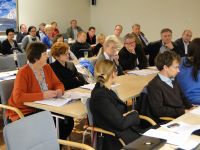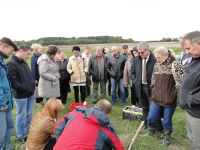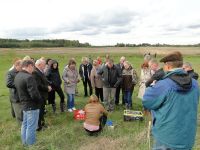



Specialist Training for Employees of the Lodz Centre of Agricultural Advice entitled ‘Buffer Zones and Other Measures to Reduce Diffuse Pollution from Agricultural Areas’
On 25-26 September 2013, in Molo Hotel situated on the Sulejow Reservoir in Smardzewice, a Specialist Training for Employees of the Lodz Centre of Agricultural Advice entitled ‘Buffer Zones and Other Measures to Reduce Diffuse Pollution from Agricultural Areas’ was held under LIFE+ EKOROB Project.
Its theoretical part included the following presentations:
- Presentation of EKOROB Project.
Wojciech Frątczak, Project Coordinator, Regional Water Management Board in Warsaw - Efficiency of vegetation buffer zones to reduce diffuse pollution from agricultural areas.
Katarzyna Izydorczyk, European Regional Centre for Ecohydrology of the Polish Academy of Sciences - Efficiency of denitrification walls to reduce pollution of groundwater with nitrogen compounds.
Agnieszka Bednarek, Department of Applied Ecology of the University of Lodz - Legal aspects of buffer zones functioning. Reduction of nitrogen losses in the context of the Agricultural and Environmental Programme.
Wioletta Dudek - Mozga, Lodz Regional Branch of the Agency for Restructuring and Modernisation of Agriculture, Office of Social and Environmental Activities and Direct Payments - Checks of farms under the Agricultural and Environmental and Mutual Conformity Programme in terms of nitrogen discharge from agricultural areas.
Marek Beker, Lodz Regional Branch of the Agency for Restructuring and Modernisation of Agriculture, Spot Control Office. - Remediation measures to reduce nitrogen and phosphorus losses from agriculture in the context of water quality protection.
Prof. Stefan Pietrzak, Department of Water Quality Protection, Institute of Technology and Life Sciences - Methods of agriculture parameterisation for the needs of modelling diffuse pollution in selected catchments in Poland.
Mikołaj Piniewski, Marek Giełczewski, Department of Hydrology and Water Resources, University of Life Sciences in Warsaw.
The practical part of the training was held in the Radonka monitoring station, and demonstration sites in Zarzęcin and Barkowice.
During the field visit, the ERCE employees discussed and demonstrated the method of sampling from piezometers and assessment of efficiency of buffer zones based on measurements of nitrate concentration in groundwater. At the Radonka monitoring station, training participants could compare efficiency provided by buffer zones with the width of 40m and 15m.
The training participants also visited demonstration sites in Zarzęcin and Barkowice, where they learnt about the rules of functioning of the newly constructed buffer zones. The key aspects of groundwater pollution with phosphorus compounds and the implemented solutions using limestone-based barriers were presented in Zarzęcin demonstration site.
A method to reduce inflow of nitrogen pollution with groundwater to the Sulejow Reservoir using denitrification wall to reinforce vegetation buffer zone was presented in Barkowice Bay demonstration site.
The final part of the training involved discussions on drafting an Action Programme for Reducing Diffuse Pollution of Agricultural Origin in the Pilica Catchment under LIFE+ EKOROB Project.
We would like to thank the training participants for the discussion: Your comments concerning options to implement proposed solutions are of special importance to us.
We would also like to thank the following persons for their assistance in organising the training: Director Barbara Günther and Waldemar Trupinda of Lodz Centre of Agricultural Advise in Bratoszewice, Director Ryszard Deluga of the Department of Agriculture and Environmental Protection of the Marshal’s Office in Lodz, and Director Włodzimierz Wojtaszek of Lodz branch of the Agency for Restructuring and Modernisation of Agriculture.


.jpg)







